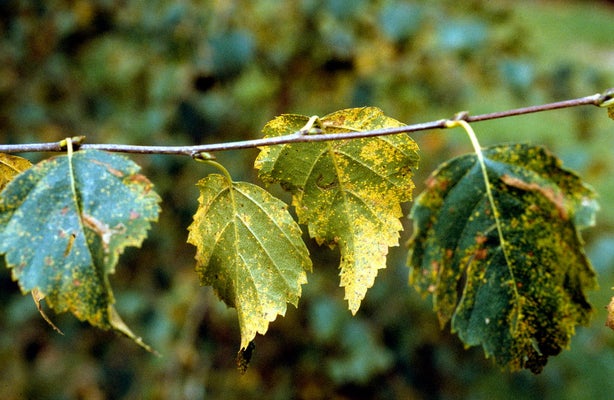
Quick facts
Common name - Rust diseases
Scientific name - Various
Plants affected - Many different garden plants
Main symptoms - Pustules on leaves and occasionally on other aerial parts. Pustules may be orange, yellow, brown, black or white in colour
Caused by - Fungus
Timing - Seen mainly in mid- to late summer and autumn
What are rusts?
The rusts are a group of fungal diseases affecting the aerial parts of plants. Leaves are affected most commonly, but rust can also be found occasionally on stems and even flowers and fruit.
The spore pustules produced by rusts vary in colour, according to the rust species and the type of spore that it is producing. Some rusts have complex life-cycles, involving two different host plants and up to five types of spore.
As well as this general introduction to rust diseases, we also have advice profiles on the rusts affecting many different plants (just click on the link to be taken to the relevant profile): Allium species, antirrhinum, box, broad bean, chrysanthemum, fuchsia, heuchera, hollyhock, iris, lawns, mint, pear, pelargonium, raspberry, rose, runner and French beans, trees.
Symptoms
Take a look at the photo gallery below for pictures of symptoms on different host plants.
You may see the following symptoms:
- Pale leaf spots eventually develop into spore-producing structures called pustules
- The pustules are found most commonly on the lower leaf surface and produce huge numbers of microscopic spores
- Pustules can be orange, yellow, brown, black or white. Some are a rusty brown colour, giving the disease its common name
- In some cases there may be dozens of pustules on a single leaf
- Severely affected leaves often turn yellow and fall prematurely
- Pustules also sometimes form on leaf stalks (petioles), stems and, rarely, on flowers and fruit
- Heavy infection often reduces the vigour of the plant. In extreme cases (e.g. with antirrhinum rust) the plant can be killed

Control
The RHS believes that avoiding pests, diseases and weeds by good practice in cultivation methods, selection, and encouraging or introducing natural enemies, should be the first line of control. If chemical controls are used, they should be used only in a minimal and highly targeted manner.
Non-chemical control
Detailed recommendations are given in the profiles available for rust diseases of individual plants and crops - see the links in the 'Biology' section, below. General recommendations are as follows:
- The development of the disease can sometimes be slowed by picking off affected leaves as soon as they are seen, provided that this involves just a small number of leaves. Removing leaves in large numbers is likely to do more harm than good
- Provide conditions that encourage strong growth, but avoid an excess of nitrogen fertiliser as this results in soft, lush growth that is easily colonised by rust
- The leaves of plants affected by rust could be composted in spring and early summer, as the spores produced then are generally short-lived and should be killed by home systems (particularly if the material is left long enough so that it is fully degraded). In late summer and autumn some rusts (usually those affecting plants) produce overwintering spores. These spores are often very resilient, so at this time it would be better to dispose of affected material by other means
- Resistant cultivars are available for some plants and crops, but this resistance is occasionally overcome by changes within the rust fungus
- In some cases no control is required. For example, many rusts of trees develop too late in the summer to have a significant effect on vigour, even though the whole tree may appear yellow or orange in late summer due to the huge number of rust pustules on the leaves
Fungicides
The RHS recommends that you don't use fungicides. Fungicides (including organic types) may reduce , impact soil health and have wider adverse environmental effects. If you do intend to use a fungicide, please read the information given in the link and download below to ensure that use, storage and disposal of the product is done in a responsible and legally compliant manner.
The products listed in the ‘Fungicides for gardeners’ document below are legally available for use by home gardeners in the UK. This information is provided to avoid misuse of legal products and the use of unauthorised and untested products, which potentially has more serious consequences for the environment and wildlife than when products are used legally. Homemade products are not recommended as they are unregulated and usually untested.
No fungicides are currently available to home gardeners with good activity against rust diseases of edible crops.
Download
Fungicides for gardeners (Adobe Acrobat pdf document outlining fungicides available to gardeners)
Link
Biology
Most of the RHS Gardening Advice enquiries regarding rust occur on the following hosts: allium species, antirrhinum, bluebell, box, chrysanthemum, fuchsia, heuchera, hollyhock, hypericum, lawn grasses, mahonia, pear, pelargonium, poplar, rose and vinca.
Rust fungi have very limited host ranges. For example, the rust that attacks antirrhinum is a different species from that affecting hollyhock. By late summer there may be many different rust species present on various plants in the garden.
Infection is favoured by prolonged leaf wetness, so rusts are usually diseases of wet summers.
Some rusts spend their entire life on one plant and produce just one or two types of spore. Others need two, often completely unrelated plants in order to complete their life-cycle, and can produce up to five different spore types. European pear rust, for example, spends part of its life on juniper.
The colour of the rust pustules varies according to the rust species and the type of spore that it is producing. Rose rust, for example, produces orange pustules for much of the summer, but in late summer and autumn these are replaced by black pustules containing overwintering spores.



























